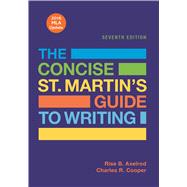THIS TITLE HAS BEEN UPDATED TO REFLECT THE 2016 MLA UPDATES! Our editorial team has updated this text based on content from The MLA Handbook, 8th Edition. Browse our catalog or contact your representative for a full listing of updated titles and packages, or to request a custom ISBN.
The new Concise St. Martin’s Guide provides streamlined coverage of the six most commonly assigned genres in first-year composition—remembering events, writing profiles, explaining concepts, arguing a position, proposing a solution, and justifying an evaluation. The Concise Guide leads students through the writing process: "Guides to Reading" equip students to analyze a genre’s basic features, and Axelrod and Cooper’s distinctive "Guides to Writing" help students apply their analysis of reading to the development of their own writing projects. With more hands-on activities for critical reading and working with sources, greater emphasis on the rhetorical situation, and a fresh new design to show students the strategies they need at a glance, the Concise Guide helps students accomplish their writing goals from start to finish. Our newest set of online materials, LaunchPad Solo, provides all the key tools and course-specific content that you need to teach your class. Get all our great course-specific materials in one fully customizable space online; then assign and mix our resources with yours. To package LaunchPad Solo free with The Concise St. Martin's Guide to Writing, use ISBN 978-1-319-00686-0.
The new Concise St. Martin’s Guide provides streamlined coverage of the six most commonly assigned genres in first-year composition—remembering events, writing profiles, explaining concepts, arguing a position, proposing a solution, and justifying an evaluation. The Concise Guide leads students through the writing process: "Guides to Reading" equip students to analyze a genre’s basic features, and Axelrod and Cooper’s distinctive "Guides to Writing" help students apply their analysis of reading to the development of their own writing projects. With more hands-on activities for critical reading and working with sources, greater emphasis on the rhetorical situation, and a fresh new design to show students the strategies they need at a glance, the Concise Guide helps students accomplish their writing goals from start to finish. Our newest set of online materials, LaunchPad Solo, provides all the key tools and course-specific content that you need to teach your class. Get all our great course-specific materials in one fully customizable space online; then assign and mix our resources with yours. To package LaunchPad Solo free with The Concise St. Martin's Guide to Writing, use ISBN 978-1-319-00686-0.








